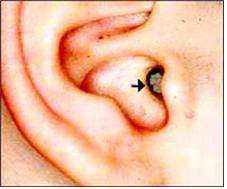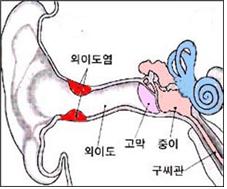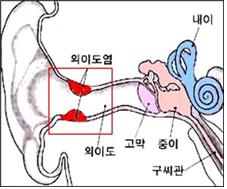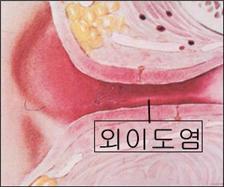수영 외이도염, Swimmer’s ears
외이도염 참조

사진 37. 외이도염으로 귓구멍이 붓고 하얀 고름이 나 있다. → 로 가르킨 하얀 것이 고름이다.
Copyright ⓒ 2011 John Sangwon Lee, M.D., FAAP

그림 38. 외이도에 생긴 염증을 외이도염이라고 한다.
Copyright ⓒ 2011 John Sangwon Lee, M.D. ,FAAP
-
외이도 피부층에는 솜털구멍(모공), 귀지분비샘(이구선), 피지샘, 땀샘(한선) 등이 있다.
-
외이도 피부층에 세균이 감염되어 생긴 염증을 세균성 외이도염이라고 한다.
-
때로는 아토피성 피부염이나 접촉성 피부염 등으로 외이도염이 생길 수 있다.
-
이때는 세균성 외이도염이라고 하지 않는다.
외이도염 분류
-
급성 국소적 외이도염, 급성 국소적 외이도염을 영어로 “Swimmer’s ear” 이라고 한다. 즉 외이도 염증이 수영을 한후나 샤워 또는 목욕을 한후 생기는 것이 보통이기 때문에 이 병명이 생긴것이다.
-
급성 광범위성 외이도염,
-
만성 외이도염,
-
악성 외이도염
-
세균성 외이도염 또는 비세균성 외이도염 등으로 분류한다.
외이도염을 일으키는 박테리아(세균)
-
외이도염의 종류에 따라 외이도염을 일으킨 세균의 종류가 다를 수 있다.
-
급성 국소 외이도염의 주 원인균은 황색 포도상구균이나 A군 베타 용혈성 연쇄상구균 등이다.
-
급성 광범위성 외이도염의 원인 균은 슈도모나스균, 황색 포도상구균, 엔테로박테리아균, 또는 푸로테리유스균 등이다.
-
만성 외이도염의 원인균은 중이염을 일으키는 세균과 같을 수 있고 다를 수 있다.
-
중이염에서 흘러나오는 고름으로 세균배양 검사를 해 원인균이 무엇인지 알아볼 수 있다.
-
세균 배양 검사에서 여러 종류의 세균들이 발견될 수 있다.
-
악성 외이도염의 원인균은 슈도모나스균이나 황색 포도상구균이다23.
-
이상 설명한 세균 이 외 다른 종류의 박테리아나, 곰팡이균(진균), 또는 바이러스 감염으로 외이도염이 생길 수 있다.
-
외이도에 박테리아 감염이 생기면 외이도 뾰루지, 또는 수영자 외이도염(Swimmer’s ear)이 생길 수 있다.
세균 이외 외이도염 원인
-
세수, 목욕, 또는 수영 중 물이 외이도 속으로 들어가면 외이도 속에 있던 마른 귀지가 젖어 외이도 속이 가려울 수 있다.
-
이때 외이도 속을 불결한 성냥개비 등으로 후비면 외이도 피부에 상처가 생길 수 있고
-
불결한 성냥개비나 Q 팁 등에서 세균이 감염되면 박테리아 화농성 외이도염에 걸릴 수 있다. 또 외이도 속으로 물이 들어가지도 않고, 귀지가 없어도 어떤 이유로 외이도 속이 가려울 수 있다.
-
외이도 내 아토피성 피부염이 있거나 지루성 피부염이 있을 때는 외이도 속이 많이 가려울 수 있다.
-
이 때 외이도 속 귀지를 성냥개비 등으로 파주면 외이도에 상처를 입힐 수 있고 그로 인해 외이도염이 생기기 쉽다.
-
헤어스프레이 또는 화장품 등으로 외이도 속 피부가 자극받으면 접촉성 피부염이 외이도 속에 생겨 그로 인해 외이도염이 생길 수 있다.
외이도염의 증상 징후

그림 39. □에 외이도염이 생겨 있다.
Copyright ⓒ 2011 John Sangwon Lee, M.D., FAAP

그림 40. 외이도염으로 외이도가 붓고 발적 됐다.
출처;Burroughs Wellcome co.
-
외이도염의 중증도와 원인 등에 따라 증상 징후가 많이 다르다.
-
외이도염이 경미하게 있을 때는 외이도 속이 좀 가렵고 아플 수 있지만, 외이도염이 심할 때는 외이도 속이 상당히 붓고 거기에 고름이 잡히고 외이도 속이 꽉 막힐 수 있다.
-
이 때 참을 수 없을 정도로 귀 전체가 욱신욱신 쑤시고 몹시 아픈 것이 보통이다.
-
외이도염으로 아주 심하게 아프면 잠도 잘 못자고 학교에 갈 수 없다.
-
외이도 입구나 이주(Tragus)를 손으로 살짝 만지거나 귓바퀴를 조금만 만져 움직여도 귀가 몹시 아플 수 있고 때로는 열이 날 수 있다.
-
외이도 내에 생긴 뾰루지가 자연적으로 터질 수 있고 거기서 회백색, 재색, 또는 노란 고름이나 진물이 귓구멍을 통해 밖으로 흘러나올 수 있다.
-
아주 심할 때는 귓구멍 바로 앞에 있는 안면 부분(이주 근방)과 귓구멍 사이에 있는 부위도 붓을 수 있다.
-
입을 크게 벌렸다 오므렸다 할 때도 그 쪽 귀가 몹시 아플 수 있다.
외이도염의 진단
-
병력, 증상 징후와 진찰소견 등을 종합해 진단한다.
-
이 직달경으로 외이도 속을 직접 들여다보고 확진할 수 있다.
-
필요에 따라 흘러나온 고름으로 세균 배양검사를 하고 항생제 세균 감수성 검사도 한다.
-
어떤 세균감염에 의해 생겼나 알아보고 어떤 종류의 항생제가 치료에 가장 적절한 지도 알아보기 위해서 세균 항생제 감수성 검사를 한다.
외이도염의 감별 진단
-
급성 또는 만성으로 생기는 중이염, 고막염, 외이도에 난 양성 또는 악성 종양, 외이도 내 이물, 유양 돌기염, 대상포진 등과 감별 진단해야 한다.
외이도염의 치료
-
외이도염의 원인과 정도에 따라 치료한다.
-
박테리아 외이도염이 심할 때는 코티손과 폴리믹신 항생제 성분이 든 코티코스포린 귀 점적제(귀 물약)나 플락신(Floxin) 귀 점적약, 또는 Ciprodex(Ciprofloxacin-dexamethasone) 귀 점적약을 중 한 종류의 귀 점적약을 의사의 처방에 따라 10일 정도 외이도 속에 넣어 치료할 수 있다. 때로는 스테로이드 성분이 들어 있지 않은 항생제 외이도염을 치료하는 귀 점적약으로 치료할 수 있다.
-
외이도염도 있고 외이도 봉소염이 동시 있을 때는 경구용 항생제를 복용하거나 항생제 주사로 치료한다.
-
그 외 더운 물수건 찜질이나 다른 방법으로 더운찜질을 1회 10~15분간, 1일 3~4회, 2~3일 간 치료할 수 있다.
-
귀가 아프면 타이레놀이나 모트린이나 코데인 등으로 진통시킨다.
-
고름이 잡힌 뾰루지는 배농 수술치료를 한다.
-
이때도 역시 더운물 수건이나 다른 방법으로 더운찜질을 하고 외이도 속에 코티코스포린 귀 점적약제 등으로 치료할 수 있다.
-
드물게 박테리아 외이도염은 옥사실린이나 다른 적절한 경구용 항생제로 치료하고 때로는 심한 외이도염은 입원치료를 받는다.
-
곰팡이 외이도염은 나이스타틴(Nystatin) 귀점적제나 클로트리마졸(Clotrimazol) 귀점적제로 치료할 수 있다.
-
습진으로 생긴 외이도염은 코르티코스테로이드제 연고나 코르티코스테로이드제 연고 귀점적제로 치료할 수 있다
-
귀지가 있으면 병원에서 조심히 흡입 제거 치료한다.
-
급성 외이도염을 코티손과 폴리믹신 항생제 성분 등이 든 코티코스포린 귀 점적제등으로 48~72시간 치료한후 치료가 되지 않으면 외이도 내에 이물이 들어 있는지 외상성 외이도염이나 습집이 있는지 봉소염이 있는지 알아보고 그 진단에 따라 치료 받는다.치
외이도염의 예방
-
외이도 속을 자주 후비는 버릇이 있거나 외이도 속에 이물이 들어 있거나 귀지로 외이도가 막혔을 때, 특히 지루성 피부염이나 아토피성 피부염이나 외이도 속에 아토피성 피부염이 있을 때 외이도염이 더 잘 생길 수 있다.
-
가려운 증상이 생기면 귓구멍 속을 함부로 후벼서는 안 된다. “귓구멍 속에는 엄마의 팔꿈치보다 더 큰 것만 넣으라.”는 말이 있다.
-
수영이나 목욕한 후 외이도 속이 가려울 때 성냥개비나 면봉 등으로 귓구멍 속을 후비지 말아야 한다.
-
70% 소독용 알코올과 식초를 동량으로 섞은 액 4방울 정도를 가려운 외이도 속에 넣든지,
-
따뜻한 물병이나 물수건으로 가려운 귀에 직접 대고 더운찜질을 하든지 적절한 헤어드라이어 열풍으로 외이도 속 물기를 말리면 가려움증이 덜할 수 있다.
-
외이도 입구를 손가락의 끝 부분으로 살살 문질러 주면 가려움증이 덜 할 수 있다.
-
이렇게 해도 계속 가렵거나 더 심하면 의사의 진단 치료를 받아야 한다.
-
가능하면, 목욕용 캡을 쓰던지 귀구멍마개나 수영몰드로 외이도 속으로 물이 들어가지 않게 한다.
Swimmer’s ears
see otitis externa

Picture 37. Otitis externa causes swelling of the ear canal and white pus. → The white thing pointed to is pus. Copyright ⓒ 2011 John Sangwon Lee, M.D., FAAP

Figure 38. Inflammation of the external auditory meatus is called otitis externa. Copyright ⓒ 2011 John Sangwon Lee, M.D.,FAAP
• In the skin layer of the external auditory canal, there are pores (pores), cerumen glands (ear glands), sebaceous glands, and sweat glands (chick glands).
• Inflammation caused by a bacterial infection in the skin layer of the external auditory meatus is called bacterial otitis externa.
• Sometimes, otitis externa can be caused by atopic dermatitis or contact dermatitis.
• In this case, it is not called bacterial otitis externa.
Classification of otitis externa
• Acute localized otitis externa, acute localized otitis externa is called “Swimmer’s ear” in English. In other words, it is common for inflammation of the ear canal to occur after swimming, showering, or bathing, so this disease has its name.
• Acute widespread otitis externa;
• Chronic otitis externa;
• Malignant otitis externa
• Classified as bacterial otitis externa or nonbacterial otitis externa.
Bacteria (bacteria) that cause otitis externa
• Depending on the type of otitis externa, the type of bacteria that causes otitis externa may be different.
• The main cause of acute focal otitis externa is Staphylococcus aureus or group A beta-hemolytic streptococcus.
• The causative agent of acute widespread otitis externa is Pseudomonas, Staphylococcus aureus, Enterobacteriaceae, or Proteobacteria.
• The causative agent of chronic otitis externa may be the same as or different from the bacteria causing otitis media.
• It is possible to identify the causative bacteria by performing a bacterial culture test with pus flowing from otitis media.
• Several types of bacteria can be found in bacterial culture tests.
• The causative agent of malignant otitis externa is Pseudomonas or Staphylococcus aureus23.
• Otitis externa can be caused by infection with other types of bacteria, fungi (fungi), or viruses other than those described above.
• Bacterial infection of the ear canal can cause ear canal rash or Swimmer’s ear.
Causes of otitis externa other than bacteria
• If water enters the ear canal while washing, bathing, or swimming, the dry earwax in the ear canal can become wet and cause itching in the ear canal.
• At this time, if you pick the inside of the ear canal with an unclean matchstick, the skin of the ear canal may be damaged.
• Bacterial otitis externa can be caused by a bacterial infection such as a dirty matchstick or Q tip. Also, even if water does not enter the ear canal and there is no earwax, the inside of the ear canal may itch for some reason.
• If you have atopic dermatitis or seborrheic dermatitis in the external auditory meatus, the external auditory meatus may be very itchy.
• At this time, if you dig the earwax out of the ear canal with a matchstick, it can injure the ear canal, which can easily cause otitis externa.
• If the skin in the ear canal is stimulated with hairspray or cosmetics, contact dermatitis may occur in the ear canal, which may lead to otitis externa.
Symptoms, signs of otitis externa

Figure 39. Otitis externa is formed in □. Copyright ⓒ 2011 John Sangwon Lee, M.D., FAAP

Figure 40. Otitis externa caused swelling and redness of the ear canal. Source: Burroughs Wellcome co.
• Symptoms and signs vary greatly depending on the severity and cause of otitis externa.
• In mild cases of otitis externa, the inside of the ear canal may be itchy and painful, but in severe cases of otitis externa, the inside of the ear canal is quite swollen, and pus may collect there and the inside of the ear canal may become clogged.
• At this time, it is common to have a throbbing pain in the entire ear to the point of being unbearable.
• If you are very sick with otitis externa, you cannot sleep well and cannot go to school.
• Even a slight touch of the entrance to the ear canal or the tragus, or even a slight movement of the pinna, can cause severe ear pain and sometimes a fever.
• A pimple that develops in the ear canal may burst spontaneously, from which grayish-white, grayish, or yellowish pus or fluid may drain out through the ear canal.
• In severe cases, swelling may also occur in the area of the face just in front of the ear canal (near the trabeculae) and between the ear canal.
• Even when you open and close your mouth wide, your ear may hurt.
Diagnosis of otitis externa
• Diagnosis is made by combining medical history, symptoms, signs, and examination findings.
• You can confirm the diagnosis by looking directly into the external auditory canal with this direct mirror.
• If necessary, a bacterial culture test is performed with the exuded pus, and an antibiotic bacterial susceptibility test is also performed.
• Bacterial antibiotic susceptibility testing to determine which bacterial infection is caused and which type of antibiotic is best for treatment.
Differential diagnosis of otitis externa
• Acute or chronic otitis media, tympanitis, benign or malignant tumors in the external auditory meatus, foreign bodies in external auditory meatus, mastoiditis, and herpes zoster should be differentially diagnosed.
Treatment of otitis externa
• Treatment depends on the cause and severity of otitis externa.
• For severe bacterial otitis externa, one of the following ear drops is corticosporin ear drops (ear drops) containing cortisone and polymyxin antibiotics, Floxin ear drops, or Ciprodex (Ciprofloxacin-dexamethasone) ear drops. According to the doctor’s prescription, the medicine can be put into the ear canal for about 10 days for treatment. Sometimes it can be treated with antibiotics that do not contain steroids and ear drops to treat otitis externa.
• If you have otitis externa and cellulitis of the otitis externa at the same time, take oral antibiotics or inject antibiotics.
• In addition, you can use a hot towel or other methods to apply hot compresses for 10 to 15 minutes at a time, 3 to 4 times a day, for 2 to 3 days.
• If your ears hurt, use Tylenol, Motrin, or Codeine for pain relief.
• Pimples with pus are treated with drainage surgery.
• At this time, too, you can apply hot compresses with a hot towel or other methods and treat with corticosporin ear drops in the ear canal.
• Rarely, bacterial otitis externa is treated with oxacillin or other appropriate oral antibiotics, and sometimes severe otitis externa is hospitalized.
• Fungal otitis externa can be treated with Nystatin or Clotrimazol.
• Otitis externa caused by eczema can be treated with corticosteroid ointment or ear drops with corticosteroid ointment.
• If there is earwax, it is carefully removed by suction in the hospital.
• If acute otitis externa is not treated after 48 to 72 hours of treatment with corticosporin ear drops containing cortisone and polymyxin antibiotic ingredients, check whether there is a foreign body in the external auditory meatus, traumatic otitis externa, blisters, cellulitis, etc. be treated accordingly.
Prevention of otitis externa
• Otitis externa is more likely to occur if you have a habit of frequently picking inside the ear canal, or if there is a foreign object in the ear canal or if the ear canal is blocked with earwax, especially if there is seborrheic dermatitis, atopic dermatitis, or atopic dermatitis in the ear canal.
• If you have itchy symptoms, do not rub the inside of your ear canal. There is a saying, “Put into the ear canal only one that is bigger than your mother’s elbow.”
• If the inside of the ear canal is itchy after swimming or bathing, do not use a matchstick or cotton swab to pick the inside of the ear canal.
• Put about 4 drops of an equal amount of 70% rubbing alcohol and vinegar into the itchy ear canal;
• Itching can be reduced by applying a hot compress to the itchy ear directly with a warm water bottle or wet towel, or by drying the moisture in the ear canal with an appropriate hairdryer.
• Itching can be reduced by gently rubbing the entrance to the ear canal with the tip of your finger.
• If the itching persists or gets worse after doing this, you should see a doctor for diagnostic treatment.
• If possible, use a bathing cap, earplugs or swimming mold to keep water out of the ear canal.
출처 및 참조 문헌 Sources and references
- NelsonTextbook of Pediatrics 22ND Ed
- The Harriet Lane Handbook 22ND Ed
- Growth and development of the children
- Red Book 32nd Ed 2021-2024
- Neonatal Resuscitation, American Academy of Pediatrics
- www.drleepediatrics.com 제1권 소아청소년 응급 의료
- www.drleepediatrics.com 제2권 소아청소년 예방
- www.drleepediatrics.com 제3권 소아청소년 성장 발육 육아
- www.drleepediatrics.com 제4권 모유,모유수유, 이유
- www.drleepediatrics.com 제5권 인공영양, 우유, 이유식, 비타민, 미네랄, 단백질, 탄수화물, 지방
- www.drleepediatrics.com 제6권 신생아 성장 발육 육아 질병
- www.drleepediatrics.com제7권 소아청소년 감염병
- www.drleepediatrics.com제8권 소아청소년 호흡기 질환
- www.drleepediatrics.com제9권 소아청소년 소화기 질환
- www.drleepediatrics.com제10권. 소아청소년 신장 비뇨 생식기 질환
- www.drleepediatrics.com제11권. 소아청소년 심장 혈관계 질환
- www.drleepediatrics.com제12권. 소아청소년 신경 정신 질환, 행동 수면 문제
- www.drleepediatrics.com제13권. 소아청소년 혈액, 림프, 종양 질환
- www.drleepediatrics.com제14권. 소아청소년 내분비, 유전, 염색체, 대사, 희귀병
- www.drleepediatrics.com제15권. 소아청소년 알레르기, 자가 면역질환
- www.drleepediatrics.com제16권. 소아청소년 정형외과 질환
- www.drleepediatrics.com제17권. 소아청소년 피부 질환
- www.drleepediatrics.com제18권. 소아청소년 이비인후(귀 코 인두 후두) 질환
- www.drleepediatrics.com제19권. 소아청소년 안과 (눈)질환
- www.drleepediatrics.com 제20권 소아청소년 이 (치아)질환
- www.drleepediatrics.com 제21권 소아청소년 가정 학교 간호
- www.drleepediatrics.com 제22권 아들 딸 이렇게 사랑해 키우세요
- www.drleepediatrics.com 제23권 사춘기 아이들의 성장 발육 질병
- www.drleepediatrics.com 제24권 소아청소년 성교육
- www.drleepediatrics.com 제25권 임신, 분만, 출산, 신생아 돌보기
- Red book 29th-31st edition 2021
- Nelson Text Book of Pediatrics 19th- 21st Edition
- The Johns Hopkins Hospital, The Harriet Lane Handbook, 22nd edition
- 응급환자관리 정담미디어
- Pediatric Nutritional Handbook American Academy of Pediatrics
- 소아가정간호백과–부모도 반의사가 되어야 한다, 이상원 저
- The pregnancy Bible. By Joan stone, MD. Keith Eddleman, MD
- Neonatology Jeffrey J. Pomerance, C. Joan Richardson
- Preparation for Birth. Beverly Savage and Dianna Smith
- 임신에서 신생아 돌보기까지. 이상원
- Breastfeeding. by Ruth Lawrence and Robert Lawrence
- Sources and references on Growth, Development, Cares, and Diseases of Newborn Infants
- Emergency Medical Service for Children, By Ross Lab. May 1989. p.10
- Emergency care, Harvey Grant and Robert Murray
- Emergency Care Transportation of Sick and Injured American Academy of Orthopaedic Surgeons
- Emergency Pediatrics A Guide to Ambulatory Care, Roger M. Barkin, Peter Rosen
- Quick Reference To Pediatric Emergencies, Delmer J. Pascoe, M.D., Moses Grossman, M.D. with 26 contributors
- Neonatal resuscitation Ameican academy of pediatrics
- Pediatric Nutritional Handbook American Academy of Pediatrics
- Pediatric Resuscitation Pediatric Clinics of North America, Stephen M. Schexnayder, M.D.
-
Pediatric Critical Care, Pediatric Clinics of North America, James P. Orlowski, M.D.
-
Preparation for Birth. Beverly Savage and Dianna Smith
-
Infectious disease of children, Saul Krugman, Samuel L Katz, Ann A.
- 제4권 모유, 모유수유, 이유 참조문헌 및 출처
- 제5권 인공영양, 우유, 이유, 비타민, 단백질, 지방 탄수 화물 참조문헌 및 출처
- 제6권 신생아 성장발육 양호 질병 참조문헌 및 출처
- 소아과학 대한교과서
-
제18권 소아청소년 이비인후과 질환 참조문헌 및 출처
-
Emergency Care Transportation of Sick and Injured American Academy of Orthopaedic Surgeons
-
Emergency Pediatrics A Guide to Ambulatory Care, Roger M. Barkin, Peter Rosen
-
Gray’s Anatomy
-
Habilitation of The handicapped Child, The Pediatric Clinics of North America, Robert H Haslam, MD.,
-
Pediatric Otolaryngology Sylvan Stool
-
Hearing Loss In children, The Pediatric Clinics of North America Nancy Roizen,MD and Allan O Diefendorf, PhD
-
Recent Advances in Pediatric otolaryngology The Pediatric Clinics of North America
-
Pediatric Otolaryngology. The Pediatric Clinics of North America, David Tunkel, MD., Kenneth MD Grundfast, MD
Copyright ⓒ 2015 John Sangwon Lee, MD., FAAP
“부모도 반의사가 되어야 한다”-내용은 여러분들의 의사로부터 얻은 정보와 진료를 대신할 수 없습니다.
“The information contained in this publication should not be used as a substitute for the medical care and advice of your doctor. There may be variations in treatment that your doctor may recommend based on individual facts and circumstances. “Parental education is the best medicine.”